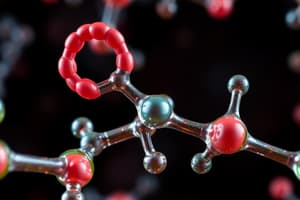Podcast
Questions and Answers
What are the common mechanisms used by enzymes to achieve catalysis?
What are the common mechanisms used by enzymes to achieve catalysis?
Proximity and Orientation Effects, General Acid and General Base Catalysis, electrostatic effects, nucleophilic and electrophilic catalysis, structural flexibility, entropy loss, desolvation, and covalent catalysis.
How do proximity and orientation effects speed the rate of a reaction?
How do proximity and orientation effects speed the rate of a reaction?
They bind substrates that are close together and in the correct orientation.
What is acid-base catalysis?
What is acid-base catalysis?
It involves proton donors and acceptors on enzyme R-groups that donate and accept protons.
What is covalent catalysis?
What is covalent catalysis?
What is entropy loss?
What is entropy loss?
What is desolvation?
What is desolvation?
What is electrostatic destabilization?
What is electrostatic destabilization?
Why is the binding between substrate and enzyme relatively tight but not too tight?
Why is the binding between substrate and enzyme relatively tight but not too tight?
What is a transition state intermediate?
What is a transition state intermediate?
What does it mean that chymotrypsin is a proteolytic enzyme?
What does it mean that chymotrypsin is a proteolytic enzyme?
What is a nucleophile?
What is a nucleophile?
Distinguish between the tetrahedral and acyl-enzyme intermediates in the chymotrypsin reaction.
Distinguish between the tetrahedral and acyl-enzyme intermediates in the chymotrypsin reaction.
Which R-groups function in the catalytic triad of chymotrypsin?
Which R-groups function in the catalytic triad of chymotrypsin?
What product of the chymotrypsin reaction is the first to be released?
What product of the chymotrypsin reaction is the first to be released?
What is the catalytic role of carbonic anhydrase?
What is the catalytic role of carbonic anhydrase?
Flashcards are hidden until you start studying
Study Notes
Enzyme Catalysis Mechanisms
- Enzymes utilize mechanisms such as Proximity and Orientation Effects, General Acid/Base Catalysis, electrostatic effects, and covalent catalysis to facilitate reactions.
- Covalent catalysis reduces transition state energy and lowers activation energy by forming a covalent intermediate.
Proximity and Orientation Effects
- These effects enable substrates to be positioned favorably and aligned correctly, maximally increasing reaction rates by promoting effective interactions.
Acid-Base Catalysis
- Proton donors and acceptors from enzyme R-groups enhance nucleophile and electrophile activity, stabilizing leaving groups and facilitating rapid reactions.
- Histidine's imidazole R-group, with a pKa near neutral pH, is pivotal in both donating and accepting protons.
Covalent Catalysis
- Forms a transient covalent bond between substrate and enzyme R-group, increasing reaction speed through the creation of a covalent intermediate.
- Examples include proteolytic enzymes like chymotrypsin, which utilize acyl-enzyme intermediates.
Entropy Loss
- Entropy loss reduces disorder, stabilizing the enzyme-substrate complex and lowering energy levels during the reaction.
Desolvation
- Involves the removal of bound water from substrates, enhancing their reactivity and promoting interactions with the enzyme.
Electrostatic Destabilization
- Results from repulsive charges between substrate and enzyme, which can be relieved during the reaction, thereby accelerating the reaction rate.
Substrate-Enzyme Binding
- Optimal binding strength ensures effective lowering of activation energy; overly tight binding raises activation energy and hinders catalysis.
Transition State Intermediate
- This intermediate is essential for catalysis and exists only during the reaction; stronger binding of the transition state compared to substrates lowers energy of activation.
Chymotrypsin Function
- As a proteolytic enzyme, chymotrypsin cleaves peptide bonds adjacent to aromatic amino acids like tyrosine, tryptophan, and phenylalanine.
Nucleophiles
- A nucleophile donates electrons to electrophiles; serine’s R-group serves as a nucleophile by forming a temporary covalent bond during chymotrypsin activity.
Tetrahedral vs. Acyl-Enzyme Intermediates
- Tetrahedral intermediates are unstable, while acyl-enzyme intermediates are more stable due to covalent bonding and charge stabilization from the oxyanion hole.
Catalytic Triad of Chymotrypsin
- Composed of histidine, asparagine, and serine, this triad plays a crucial role in proton transfer and stabilization during catalysis, with histidine directly interacting with serine.
Products of Chymotrypsin Reaction
- The amine product is released first, while the carboxylic acid portion remains covalently attached to the enzyme as part of the acyl-enzyme intermediate.
Evolutionary Relationships of Serine Proteases
- Related serine proteases exhibit structural and functional similarities; however, some share mechanisms without having a common evolutionary origin.
Carbonic Anhydrase Function
- Catalyzes the conversion of carbon dioxide and carbonic acid, aiding in carbon dioxide transport through blood.
- Zinc in the active site lowers water's pK, facilitating rapid hydroxyl ion production, which then converts carbon dioxide into bicarbonate ions.
Studying That Suits You
Use AI to generate personalized quizzes and flashcards to suit your learning preferences.




